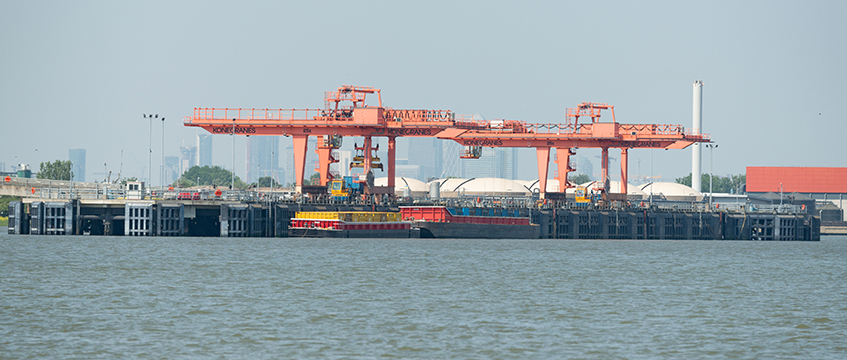The Port of London Authority will today unveil the first instalment of the Tidal Thames Masterplan, as it begins to deliver an “essential guide” for investment across all 22 local authority areas along the river’s banks.
The first masterplan covers the outer-London borough of Bexley, which spans the Thames-side towns of Belvedere, Erith and Slade Green, and follows a six-week public consultation this summer.
This will be followed by masterplans for Newham and Tower Hamlets, with the next five local authorities expected to be announced next year.
The Tidal Thames masterplan will eventually detail the potential to boost trade, travel, sport and the environment all the way along the 95-mile course of the river between Teddington in west London and the North Sea. It will support the Port of London Authority’s delivery of the Thames Vision 2050.
In Bexley, the opportunities identified include the introduction of the borough’s first river bus station, connecting it with central London.
The masterplan also highlights the potential to maximise use of the borough’s safeguarded wharves, including at Middleton Jetty in Belvedere, which forms part of waste management firm Cory’s decarbonisation project.

Bexley’s large river front includes seven safeguarded wharves, meaning they are protected for the purposes of water-borne freight handling. They are used to transport around two million tonnes of cargo on the river. This is set to increase through the reactivation of vacant and underused wharves such as Standard Wharf in Erith, which recently received planning permission to restart the transportation of construction materials and other cargo.
James Trimmer, planning and development director at the Port of London Authority, said the safeguarded wharves could play a key role in transporting the construction materials needed to build thousands of new homes in Bexley.
Housing growth in the borough is set to increase Bexley’s population from 246,500 in 2021 to approximately 267,800 by 2041. At least 10,800 jobs are also expected to be created locally over this period. If adequate infrastructure is provided, the Bexley Growth Strategy (2017) indicates that a further 10,000 homes and 6,700 jobs could be added by 2050.
Other opportunities identified in the masterplan include the promotion of existing riverside sporting facilities, such as Erith Yacht Club and Erith Rowing Club. It also highlights the importance of the tidal Thames and its local tributaries and other water courses, such as the River Darent and Dartford Creek, along with Erith & Crayford Marshes, in providing valuable habitats for wildlife.
The potential for environmental improvements, such as living walls, litter reduction and saltmarsh restoration, is outlined in the masterplan too. Such initiatives are potential beneficiaries of the biodiversity net gain scheme, which comes into force next year. This requires developers to boost the local environment when planning construction works.
Trimmer said: “We can provide this all-in-one resource: as well as the masterplan, there is guidance there for developers as to how they can create the biodiversity net gain that they need to do with development going forward.”
Investment to tackle the risk of flooding in the borough, associated with rising sea levels, is also highlighted, with the Environment Agency playing a key role in the consultation.
Trimmer said: “Aligned with the Thames Vision’s three central themes – Trading Thames, Destination Thames and Natural Thames – we have collated the feedback we received during the Bexley consultation to document the scope for maximising the economic, environmental and social potential of the river locally.
“As we expand the process to other boroughs, the Tidal Thames Masterplan will become an essential guide for investment across all the 22 local authority areas along the river’s banks.”
Senior planning officer Michael Atkins said the masterplan should help to streamline the planning process for developers by setting out the uses which the Port of London Authority thinks could work in each area. The masterplanning process is also serving to highlight good and bad practice when it comes to riverside development throughout London.
Baroness O’Neill of Bexley, leader of Bexley Council, said: “The publication of the draft Tidal Thames Masterplan is a really positive and welcome contribution to how we look at the future improvement and management of the Thames in our borough. We know the value of the waterfront and how much more could be done to utilise this important riverbank asset.
“The option of Bexley’s first river bus station and the potential use of the existing facilities is brilliant news for the borough.”
Richard Wilkinson, who is leading Cory’s development of a second energy-from-waste plant at Belvedere, said: “For a river-based business such as Cory, the Tidal Thames Masterplan for Bexley is an incredibly useful resource, with lots of relevant information and signposting.
“As the Tidal Thames Masterplan is developed, it has great potential to demonstrate the strength and breadth of the tidal River Thames, how it is used now and opportunities for the future.
“We are particularly interested in how the masterplan will build on the current data to show river connections between sites and show how river access points, including safeguarded wharves, relate to the strategic road and rail network, particularly where there are likely to be opportunities to develop intermodal freight transfers.”
Later this month, the PLA will launch an eight-week public consultation to inform its masterplans covering Newham and Tower Hamlets in east London.
“We will hopefully increase our engagement with developers to help shape these plans,” Trimmer said.
To send feedback, e-mail julia.cahill@eg.co.uk or tweet @EGJuliaC or @EGPropertyNews











